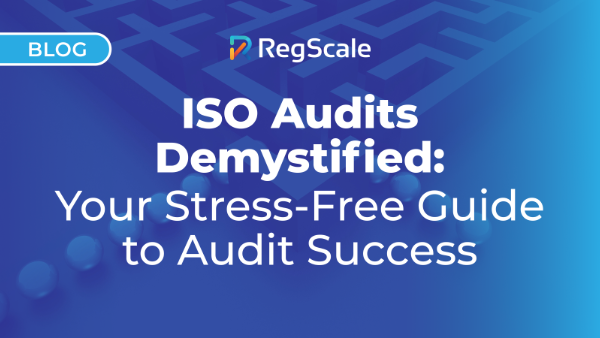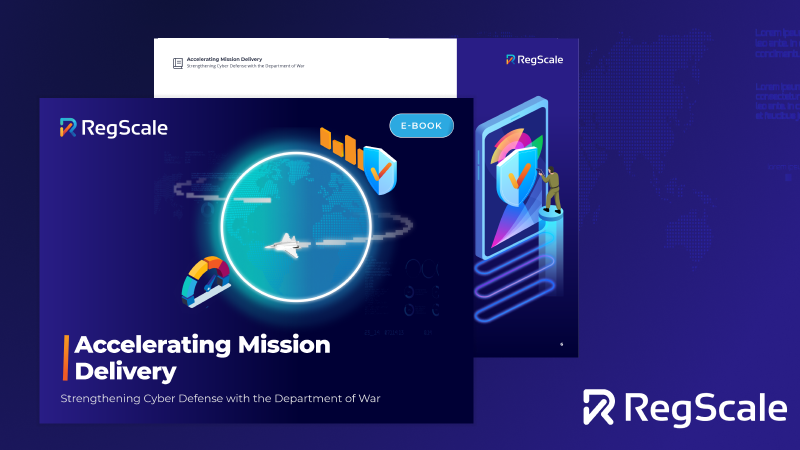ISO Audits Demystified: Your Stress-Free Guide to Audit Success

If you’ve ever felt your heart rate spike at the mention of an upcoming ISO audit, you’re not alone. The good news? ISO audits don’t have to be completely dread-inducing. With the right preparation and understanding, they can even become an opportunity to strengthen your organization and demonstrate your commitment to quality.
Whether you’re preparing for your first certification audit or looking to streamline your ongoing compliance efforts, this guide will walk you through everything you need to know. From understanding the different types of audits to mastering the preparation process, we’ll help you approach your next ISO audit with confidence rather than dread.
What is an ISO audit?
Because there are so many different ISO standards (more about this in a bit), an ISO audit can mean many different things. Broadly speaking, though, it’s a systematic examination of your organization’s processes, procedures, and documentation that’s conducted to verify your compliance with a global standard from the International Organization for Standardization. Think of it as a thorough health check for your company.
During an ISO audit, trained auditors will review your organization’s processes against the requirements of the specific ISO standard at hand. They may examine everything from your documentation and records to how your employees actually carry out their daily tasks. This audit process helps to identify areas where your organization excels and to spot any issues that need attention.
The International Organization for Standardization has developed its standards to help businesses maintain consistent quality, improve efficiency, and meet regulatory requirements. Whether you’re dealing with ISO 9001 for quality management, ISO 27001 for information security, or any other ISO standard, the audit will serve as your roadmap to continuous improvement.
Why are ISO audits important?
ISO audits play a crucial role in maintaining and improving your organization’s management systems. Here are a few reasons why they matter so much for your business.
Ensuring ongoing compliance is probably the most obvious benefit. Regular audits help you stay aligned with ISO requirements and catch any control drift before it becomes a major issue. This proactive approach saves you from costly corrections down the line.
Driving continuous improvement is where ISO audits really shine. Each audit provides valuable insights into how your processes are actually working versus how they’re supposed to work. The audit findings often reveal opportunities to streamline workflows, reduce waste, and enhance overall efficiency.
Building stakeholder confidence also becomes easier when you have a solid audit trail. Customers, partners, and regulatory bodies trust organizations that can demonstrate consistent adherence to international standards.
Risk management gets a significant boost from regular ISO audits. By identifying potential issues early, you can implement corrective actions before problems escalate into major business disruptions or compliance violations.
What are the most common ISO standards?
There are over 25,000 ISO international standards in existence today, covering everything from bicycle safety requirements to energy management operations. However, some standards are much more common and well-known than others. Here are a few of the top standards you’re likely to encounter.
ISO 9001 is the gold standard for quality management systems (QMS). This standard focuses on customer satisfaction, process improvement, and consistent delivery of products or services. It can be applicable to virtually any organization regardless of size or industry, making it one of the most widely adopted ISO standards globally.
ISO 14001 addresses environmental management systems and helps organizations minimize their environmental impact. Companies use this standard to develop systematic approaches to environmental responsibility, from reducing waste to managing energy consumption more effectively.
ISO 27001 covers information security management systems (ISMS), making it increasingly critical in our digital age. This standard helps organizations protect sensitive information through comprehensive risk assessment and security controls.
ISO 45001 focuses on occupational health and safety management systems. It provides a framework for creating safer, healthier workplaces while reducing workplace injuries and illnesses.
ISO 13485 specifically targets medical devices and establishes quality management system requirements for organizations in the medical device industry. Healthcare companies rely on this standard to ensure their products meet stringent safety and efficacy requirements.
ISO 22000 addresses food safety management systems, helping organizations in the food chain maintain safe food production and handling processes. From farms to restaurants, this standard ensures food safety throughout the supply chain.
What are the three types of ISO audits?
Although there are thousands of different ISO standards, there are three types of ISO audits. Understanding the different types — each of which serves a distinct purpose and involves different parties — will help you navigate the certification process and maintain ongoing compliance more effectively.
1. First-party audits (a.k.a. internal audits)
Internal audits are conducted by your own organization using internal auditors or hired consultants who report directly to your management team. Think of these as your regular self-assessments: they’re proactive checks you perform to ensure everything is running smoothly. You’ll follow a structured audit plan to examine different areas of your organization systematically, checking that your actual practices align with your documented procedures.
The beauty of internal audits lies in their flexibility. You can schedule them based on your business needs, focus on high-risk areas, or conduct them before major external audits. Many organizations run internal audits annually, though some prefer more frequent spot checks in critical areas.
Internal audits serve as your early warning system for potential non-compliance issues. When your internal auditors identify gaps or non-conformities, you have time to implement corrective actions before they’re spotted during external audits, saving significant time and money.
2. Second-party audits (a.k.a. supplier audits)
Second-party audits are external audits performed on your organization by one of your customers (or by an outside consulting firm acting on behalf of your customer). Unlike internal audits that you conduct yourself, these audits are initiated and controlled by an external party. When you’re on the receiving end of a second-party audit, it means one of your customers wants to verify that you’re delivering what you’ve promised according to your contractual agreements.
Second-party audits are particularly common in industries with complex supply chains, such as the automotive, aerospace, medical device, and manufacturing sectors. Large customers often require supplier audits before establishing long-term partnerships to help them assess supplier risk and ensure their partners maintain appropriate quality standards.
The results from second-party audits can provide valuable external validation for your business. Many organizations combine these external perspectives with their internal audit findings to build a comprehensive view of their compliance readiness. This combination approach helps identify blind spots and ensures you’re well-prepared for third-party certification audits.
3. Third-party audits (a.k.a. external audits)
External audits are conducted by independent third-party organizations like certification bodies or registrars. These are the “official” audits that determine whether you achieve or maintain your ISO certification (depending on whether you’re doing an initial certification audit or an annual surveillance audit). Every three years, you’ll also undergo a recertification audit: a more comprehensive review by the external auditors that allows you to renew your ISO certification.
In a third-party ISO audit, the external audit team will review your documentation, interview employees, go on-site to observe processes in action, and examine audit findings from your internal audits. They’ll bring fresh eyes to your systems and ultimately issue a formal audit report detailing any non-conformities and recommendations for improvement.
These third-party audits carry significant weight because they provide independent verification of your ISO compliance. The certification you receive will also become a valuable business asset, opening doors to new markets and strengthening customer confidence that your organization is following international best practices.
How to prepare for an ISO audit
Preparing for an ISO audit doesn’t have to be overwhelming. The key is starting early and creating a comprehensive preparation strategy. Whether you’re facing your first certification audit or preparing for routine surveillance audits, following a structured approach will help you be successful.
- Start with a thorough gap analysis to identify where your current processes might fall short of ISO requirements. This involves comparing your existing procedures, documentation, and practices against the specific ISO standard you’re working toward.
- Review and update your documentation to ensure everything reflects your current processes accurately. Outdated procedures or inconsistent documentation are red flags for auditors.
- Train your audit team and employees on what to expect from during the audit process. Many audit findings stem from employees not understanding their roles in following ISO requirements or being unable to explain their processes clearly to auditors.
- Organize your records and evidence in a logical, easily accessible format. Auditors will want to see concrete proof — and depending on the ISO standard in question, that could include everything from quality manuals and work instructions to records of corrective actions and internal audit reports.
- Prepare your audit schedule and logistics well in advance. Coordinate with the certification body to ensure your key personnel are available during the audit and to minimize disruption to your normal operations.
- Create and share an audit plan that outlines the audit scope, timeline, and key focus areas. The plan should include which business processes will be examined, which employees will be interviewed, and what documentation will be reviewed.
- Establish clear follow-up procedures for addressing any audit findings that may arise. Having a robust system for handling non-compliance issues demonstrates your commitment to continuous improvement and shows auditors that you take their findings seriously.
Remember that your prep work isn’t just about passing the audit — though that’s vitally important, too. The most successful organizations view audit preparation as an opportunity to streamline their processes, improve risk management, and strengthen their overall operational effectiveness.
Streamline your ISO audit prep with RegScale
The tools you use for audit prep can make the difference between a smooth process and a chaotic struggle — and managing your ISO audit preparation manually through spreadsheets and disconnected systems is a surefire way to create unnecessary complexity and risk.
RegScale’s Continuous Controls Monitoring platform transforms how organizations approach audit prep by centralizing documentation, streamlining audit processes, and providing real-time visibility into compliance status. Instead of spending weeks gathering documentation and coordinating evidence, you can focus on the strategic aspects of your audit preparation while RegScale automates the rest.
Ready to transform your ISO audit experience? Discover how RegScale can help your organization achieve more efficient, less stressful audit prep while strengthening your overall compliance program.
Ready to get started?
Choose the path that is right for you!
Skip the line
My organization doesn’t have GRC tools yet and I am ready to start automating my compliance with continuous monitoring pipelines now.
Supercharge
My organization already has legacy compliance software, but I want to automate many of the manual processes that feed it.
